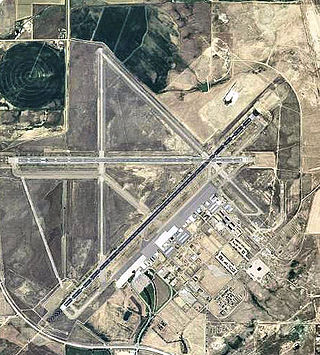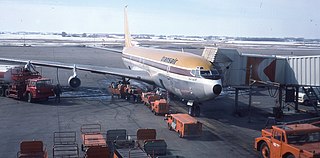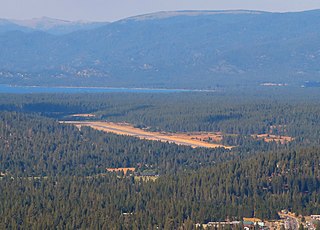
Canadian Pacific Air Lines was a Canadian airline that operated from 1942 to 1987. It operated under the name CP Air from 1968 to 1986. Headquartered at Vancouver International Airport in Richmond, British Columbia, it served domestic Canadian as well as international routes until it was purchased by Pacific Western Airlines and absorbed into Canadian Airlines International.
Pacific Western Airlines Ltd (PWA) was an airline that operated scheduled flights throughout western Canada and charter services around the world from the 1950s through the 1980s.
Trans International Airlines (TIA) was an airline that offered charter service from and within the United States. It also operated scheduled passenger service flying as Transamerica Airlines as well as charter flights during its last decade. Its headquarters were on the grounds of Oakland International Airport (OAK) in Oakland, California.

Nordair was a Quebec-based airline in Canada founded in 1947 from the merger of Boreal Airways and Mont Laurier Aviation.

Billings Logan International Airport is in the western United States, two miles northwest of downtown Billings, in Yellowstone County, Montana. It is the fourth largest airport in Montana, having been surpassed in recent years by Bozeman, Missoula, and Flathead County (Kalispell) in both number of gates as well as annual enplanements. Owned by the city of Billings, the airport is on top of the Rims, a 500-foot (150 m) cliff overlooking the downtown core, and covers 2,500 acres of land.

Combi aircraft in commercial aviation are aircraft that can be used to carry either passengers as an airliner, or cargo as a freighter, and may have a partition in the aircraft cabin to allow both uses at the same time in a mixed passenger/freight combination. The name combi comes from the word combination. The concept previously existed in railroading, as a passenger car that contained a separate compartment for mail and/or baggage.

Casper–Natrona County International Airport is 7 miles (11 km) northwest of Casper, in Natrona County, Wyoming. Before December 19, 2007 the airport was called Natrona County International Airport.

Fort Smith Regional Airport is a public use joint civil–military airport located near the Interstate 540 freeway three nautical miles (6 km) southeast of the central business district of Fort Smith, in Sebastian County, Arkansas, United States. FSM is governed by the Fort Smith Airport Commission as established by the City of Fort Smith, Arkansas. It serves the transportation needs of residents and businesses of western Arkansas and eastern Oklahoma. FSM is currently served by American Eagle, the regional airline affiliate of American Airlines. It has a large population of corporate and general aviation aircraft. A full-service fixed-base operator (FBO), Signature Flight Support, provides service to general aviation, airline, and military operators.
Kelowna Flightcraft Air Charter trading as KF Cargo and Kelowna Flightcraft trading as KF Maintenance and Engineering is a cargo airline based in Kelowna, British Columbia, Canada. It operates long term cargo charters for couriers and freight companies, forest fire patrols, and aircraft sales and leasing in Canada and worldwide. It also provides maintenance and aircraft manufacturing services.
Compagnie Africaine d'Aviation, renamed FlyCAA in 2013, is a regional airline from the Democratic Republic of the Congo, based at N'djili Airport in Kinshasa. It offers an extensive network of domestic scheduled passenger flights, as well as cargo flights. Due to safety and security concerns, CAA has been included in the list of air carriers banned in the European Union.
Quebecair was a Canadian airline that operated from 1947 until 1986. Quebecair was headquartered in Saint-Laurent, Quebec, now a part of Montreal.

The Convair CV-240 is an American airliner that Convair manufactured from 1947 to 1954, initially as a possible replacement for the ubiquitous Douglas DC-3. Featuring a more modern design with cabin pressurization, the 240 series made some inroads as a commercial airliner, and had a long development cycle that produced various civil and military variants. Though reduced in numbers by attrition, various forms of the "Convairliners" continue to fly in the 21st century.

Transair was an airline based in Canada. It was purchased by Pacific Western Airlines in 1979. Transair's operational headquarters was located at the Winnipeg International Airport in Manitoba.
Aspen Airways was an airline carrier and regional affiliate of United Express and based in Hangar 5 in Stapleton International Airport in Denver, Colorado. Aspen ceased operations on April 1, 1990, when separate portions of the airline were acquired by Mesa Airlines and Air Wisconsin Services, Inc.
National Airlines was a major airline in the United States that operated from 1934 to 1980, when it merged with Pan Am. For most of its existence the company was headquartered at Miami International Airport, Florida. At its height, National Airlines had a network of "Coast-to-Coast-to-Coast" flights, linking Florida and Gulf Coast destinations such as New Orleans and Houston with cities along the East Coast as far north as Boston as well as with large cities on the West Coast including Los Angeles, San Francisco and Seattle. From 1970 to 1978, National, Braniff International Airways, Pan American World Airways and Trans World Airlines (TWA) were the only U.S. airlines permitted to operate scheduled passenger flights to Europe.

Lake Tahoe Airport is a public airport three miles southwest of South Lake Tahoe, in El Dorado County, California. It covers 348 acres (141 ha) and has one runway; it is sometimes called Tahoe Valley Airport. Although the airport had almost forty years of airline service, since 2000 it has served only general aviation.
Denver Ports of Call is a defunct United States private airline which operated flights for the Denver-based Ports of Call Travel Club from 1967 to 1992. In its heyday, Ports of Call was the largest travel club in the United States, with at one time over 66,000 members.
Key Airlines was founded as Thunderbird Airlines in 1964 and then changed its name in 1969. The airline took over Sun Valley Airlines in 1972 and became known as Sun Valley Key Airlines for several years until reverting to the Key Airlines name. The airline began as a commuter and charter air carrier in the western United States flying turboprop and prop aircraft. In later years, Key Airlines operated a hub in Savannah, Georgia with scheduled passenger flights operated with mainline jet aircraft to international and domestic destinations.
Acadiana Regional Airport is a public use airport in Iberia Parish, Louisiana, United States. It is owned by Iberia Parish, managed by the Iberia Parish Airport Authority and is located four nautical miles (7 km) northwest of the central business district of New Iberia, Louisiana near U.S. 90.

Intrastate airlines in the U.S. are defined as air carriers operating inside of one individual state and thus not flying across state lines. Larger intrastate airlines in the U.S. that operated mainline turboprop and/or jet aircraft were created as a result of former federal airline regulations, as passenger air carriers that only flew intrastate service were not regulated by the federal government but were instead primarily regulated by the respective state governments in their home states. For example, Pacific Southwest Airlines (PSA) and Air California were both regulated by the California Public Utilities Commission (CPUC) prior to the federal Airline Deregulation Act of 1978. Although intrastate airlines in some states used only turboprop aircraft, scheduled passenger service on jet aircraft was operated by intrastate air carriers in California, Florida, Hawaii and Texas.












